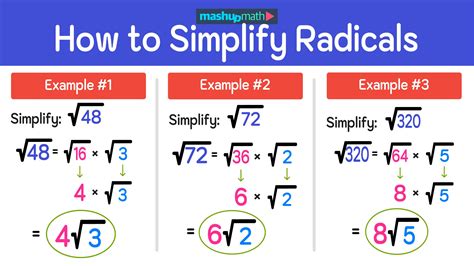Radical form in math can seem like a daunting concept, but it's actually quite straightforward once you understand the basics. In this article, we'll break down the concept of radical form, its importance, and how to work with it.
What is Radical Form in Math?

In mathematics, radical form refers to a way of expressing numbers that involve roots, such as square roots, cube roots, or nth roots. Radical form is used to simplify complex expressions and make them easier to work with.
Why is Radical Form Important?
Radical form is essential in various mathematical operations, including algebra, geometry, and calculus. It helps to:
- Simplify complex expressions
- Perform operations with roots
- Solve equations involving radicals
Understanding Radical Form

Radical form consists of three main parts:
- Radical sign: The symbol used to indicate the root, such as √ (square root), ∛ (cube root), or nth root.
- Index: The number that indicates the type of root, such as 2 for square root or 3 for cube root.
- Radical: The number or expression inside the radical sign.
Types of Radical Form
There are several types of radical form, including:
- Square root: √x (x is the radicand)
- Cube root: ∛x (x is the radicand)
- Nth root: x (n is the index, x is the radicand)
Working with Radical Form

Here are some key rules to keep in mind when working with radical form:
- Multiplication and division: Radical expressions can be multiplied and divided like regular numbers, but the index must be the same.
- Addition and subtraction: Radical expressions can be added and subtracted, but the index and radicand must be the same.
- Simplifying radicals: Radical expressions can be simplified by finding the largest perfect square or perfect cube that divides the radicand.
Examples of Radical Form
Here are some examples of radical form in action:
- Simplifying a square root: √16 = √(4 × 4) = 4
- Multiplying radicals: √2 × √3 = √(2 × 3) = √6
- Dividing radicals: √12 ÷ √4 = √(12 ÷ 4) = √3
Rationalizing the Denominator

When working with radical form, it's often necessary to rationalize the denominator. This means eliminating any radical expressions in the denominator.
Here's an example:
- Rationalizing the denominator: 1/√2 = 1/√2 × (√2/√2) = √2/2
Common Radical Form Mistakes

Here are some common mistakes to avoid when working with radical form:
- Incorrect index: Make sure the index is correct and consistent.
- Incorrect radical sign: Use the correct radical sign for the type of root.
- Insufficient simplification: Make sure to simplify radical expressions fully.
Conclusion

Radical form in math is an essential concept that can seem daunting at first, but with practice and patience, it becomes second nature. By understanding the basics of radical form and following the rules and examples outlined in this article, you'll be well on your way to mastering this important mathematical concept.
We hope this article has helped you to understand radical form in math. Do you have any questions or comments? Share your thoughts in the comments section below!
What is the purpose of radical form in math?
+Radical form is used to simplify complex expressions and make them easier to work with. It helps to perform operations with roots, solve equations involving radicals, and is essential in various mathematical operations.
What are the three main parts of radical form?
+The three main parts of radical form are the radical sign, the index, and the radicand.
What is rationalizing the denominator in radical form?
+Rationalizing the denominator means eliminating any radical expressions in the denominator.
